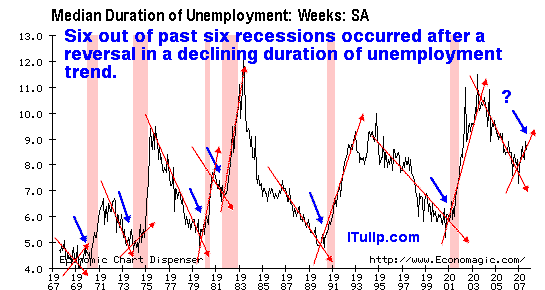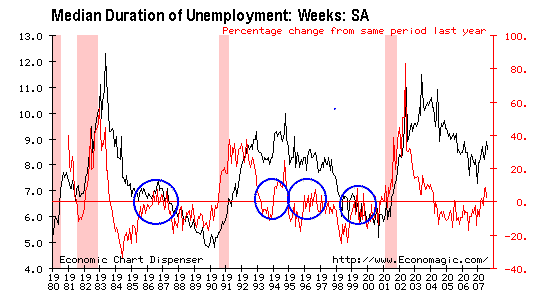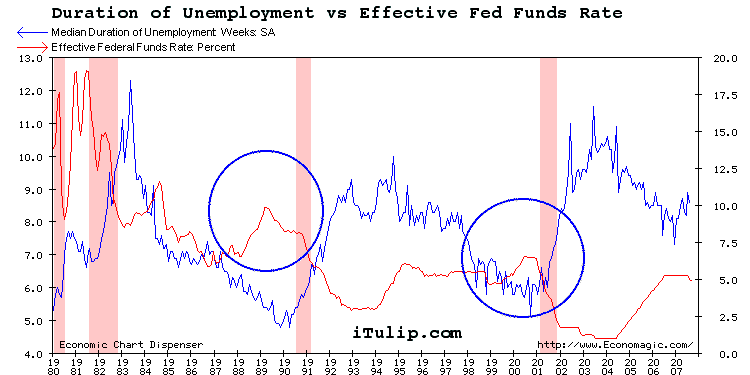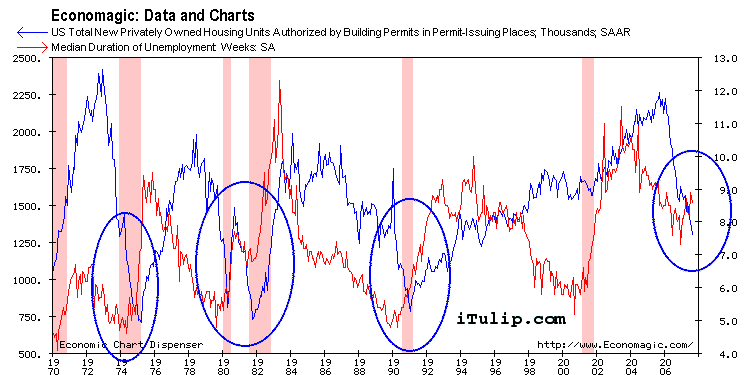By iTulip.com | 5 October 2007
Yesterday investors were surprised by a Labor Department report that showed a gain in jobless claims and a drop in factory orders. But, today was all cheer again as the new employment numbers came in "not so bad."
The Associated Press reported that
- "Wall Street appears optimistic the Labor Department report Friday will indicate a rebound from August and include revisions to that month's dismal numbers. August's job creation report showed a decline in payrolls when economists had predicted a rise, and sent the Dow Jones industrial average down nearly 250 points the day it was released."
Early in an economic slowdown, six months or more before companies lay off employees, they first slow and then stop new hiring. As thousands of employers first reduce then stop hiring as the economy slows, anyone who is laid off experiences finding a new job takes longer and longer.

Click Here, or on the image, to see a larger, undistorted image.
The economic factors causing employers to reduce hiring are causing the rise in Duration Of Unemployment. At some point the process becomes self-reinforcing; the longer more people stay unemployed, the more spending and consumption is reduced, the more demand declines, the more pressure on firms to reduce head count rises, and so on.
A rising trend change in the duration of unemployment does not, of course, in itself indicate a future recession. Since 1980, Duration Of Unemployment has turned up as much as it has today four times without a recession before reversing.

Click Here, or on the image, to see a larger, undistorted image.
One of the reasons a trend change in duration of unemployment does not always correlate to recession is Fed policy. The chart below shows the past two Fed tightening induced recessions. Even aggressive rate cuts following a tightening cycle in the presence of rising duration of unemployment failed to prevent recession. The Fed's tightening certainly put the kibosh on the real estate sub-sector of the FIRE Economy, but did little to blunt inflation in the Production/Consumption Economy, as indicated by rising oil and commodity prices.

Click Here, or on the image, to see a larger, undistorted image.
Duration Of Unemployment when plotted with Declines In Housing Permits Issued produces a chart that shows that for all recessions since 1970 (with the exception of the post stock bubble recession in early 2001), whenever permits issuance falls as long and as hard as it has, while duration of unemployment has risen as much and as long as it has, recession has not been far behind.

Click Here, or on the image, to see a larger, undistorted image.
Normxxx
______________
The contents of any third-party letters/reports above do not necessarily reflect the opinions or viewpoint of normxxx. They are provided for informational/educational purposes only.
The content of any message or post by normxxx anywhere on this site is not to be construed as constituting market or investment advice. Such is intended for educational purposes only. Individuals should always consult with their own advisors for specific investment advice.

No comments:
Post a Comment